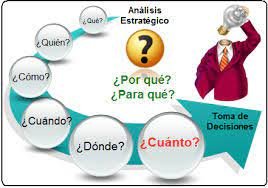Within my research readings I found The Multi-Criteria Decision Making Methods, which I found an interesting and proper content to share with you.
Sometimes we believe that life is complicated, but in reality we ourselves are the ones who fill it with barriers, we even sabotage the best scenarios ¿What is the reason? ¡The pillow! -NO, run and rescue it from the trash can, it is not responsible-. It is due to the bad decision or the wrong decision in that specific situation. That is why you should be cautious when making the decision and there are methods that facilitate and ensure being assertive. I invite you to learn more about them:
A tool to support the decision making process, it is used to facilitate the path to the decision, so that different points of view are involved, even if they are contradictory, simplifying complex situations.
It is necessary to have more than one criterion for this method to be applied, only then it will be recognized as Multicriteria. This case is presented when the solution alternatives are adapted to the objective being sought, visualizing the factors involved as well as the existing preferences.
The alternatives are selected by means of a hierarchical model, in which the information is broken down in a staggered manner for a particular problem: the highest level is the goal, the following levels are the general objectives and criteria that affect the problem, and at the lowest level are the alternatives to be evaluated.
Some of the areas in which this type of methods have made incursions with their techniques are: management of sustainable policies in the selection of the best vehicles by the Belgian government presented by Turcksin, Bernardini, & Macharis in 2011.

Stages or steps to be evaluated:
IDENTIFICATION OF THE SITUATION.
In real life it is very likely to find decision making problems with multiple qualitative and quantitative criteria, in which multiple decision makers must participate and it is necessary to determine the solution that best suits the specific problem. In some cases, it is possible to apply pure methods to solve the problem, however, there is a set of problems in which an adequate handling of the qualitative criteria is required. In these cases, the use of hybrid methods is required, which allow combining the hierarchical multi-criteria methods with other techniques, in order to give an adequate treatment to these criteria and thus obtain more satisfactory solutions for the decision makers.
ACTOR OF THE PROBLEM SITUATION
Study the environment where the problem occurs, since it involves the weighting of multiple related factors. For example: market, economy, supply and demand.
CAUSES THAT GENERATE THE PROBLEM SITUATION
In any environment, decision making becomes a risk situation, and when the causes that generate them are visualized by means of a rigorous assessment, uncertainty and, therefore, vulnerability to risk can be reduced.
CONSEQUENCES THAT THE PROBLEM SITUATION GENERATES OR WOULD GENERATE
In this step it is easy to locate the answer, since it is about the threats or weaknesses that at the moment are presented as a result caused by the problem.
In such a scale the decision maker can articulate his preferences and comments regarding two elements verbally and represent them numerically through a numerical scale from one to nine in a hierarchical manner according to the criteria for the solution of the problem.
ANALYZE HOW THE ENVIRONMENT CAN INTERVENE IN THE SELECTION OF PROPOSED ALTERNATIVES.
Analysis of the external context
This analysis shows the influences that the general or specific environment offers to the person's performance. It is a subjective and qualitative analysis, so different analysts may arrive at different results. The key is to understand that when the behavior of each of the key factors is subjectively assessed, the opportunities and threats of a decision for an environment can be seen.
The generic environment talks about the influencing factors. These are political, economic, legal, technological and socio-cultural factors.
The specific environment on the other hand focuses on those parts of the environment that specifically affect.
Analysis of the internal context
Seeks to identify the strengths and weaknesses of the author:
- see strengths and weaknesses through functional areas.
- Value chain: based on how it generates value.
The application of the methodology does not guarantee the choice of an optimal decision; however, it offers good decisions through analytical criteria.


